15 Yellow Belly Birds In Texas (With Pictures)
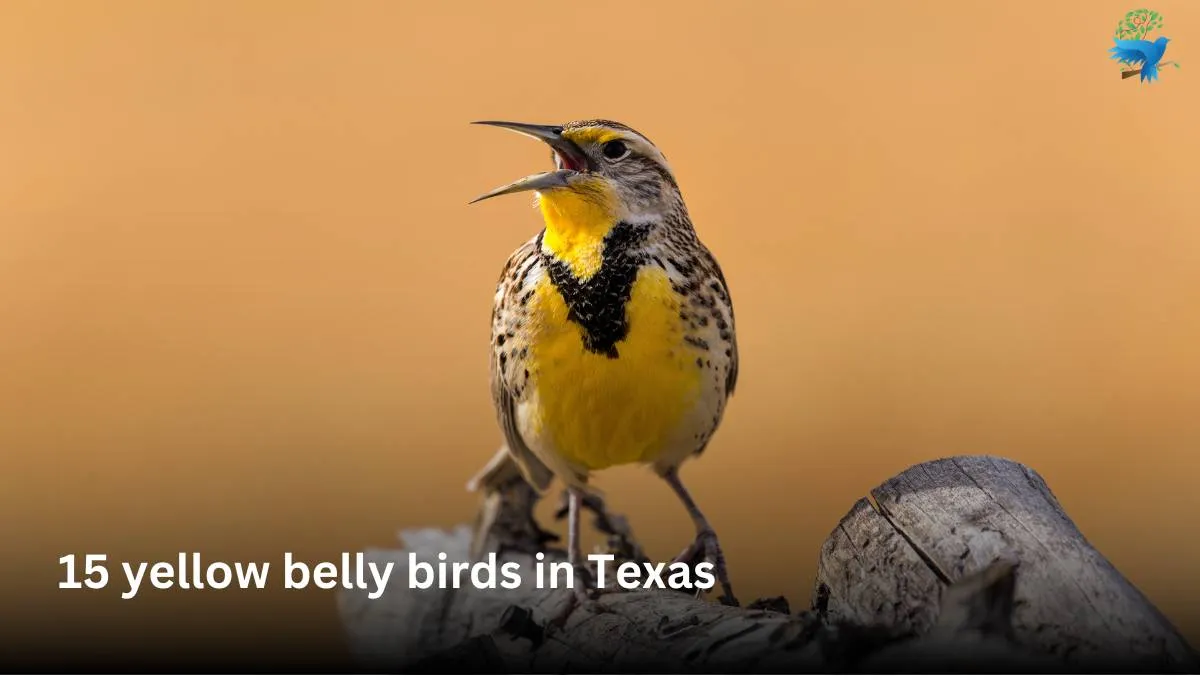
Texas, known for its various habitats, is a paradise for birdwatchers and lovers alike. The Texas Bird Records Committee (TBRC) of the Texas Ornithological Society reported 664 bird species.
One of the primary reasons Texas has so many birds is its location. Texas is located in the southern United States and the continent’s center.
So, are you excited to learn about the various bird species in Texas? In this blog, we will learn all about yellow-belly birds in Texas.
Birds with yellow bellies surround us everywhere we go. It is bright and joyful, and yellow is one of the most common shades in the bird world.
Do you ever wonder which birds with yellow bellies come to the area around your house? Stick to the end and learn in detail.
List of 15 Yellow Belly Birds in Texas
- Northern Flicker (Colaptes auratus)
- Canada Warbler (Cardellina Canadensis)
- American Yellow Warbler (Setophaga Petechia)
- Common Yellow Throats (Geothlypis Trichas)
- Pine Warbler (Setophaga Pinus)
- Cedar Waxwing (Bombycilla Cedrorum)
- Wilson’s warbler (Cardellina Pusilla)
- Audubon’s Oriole (Icterus Graduacauda)
- Lesser Goldfinch (Spinus Psaltria)
- Couch’s Kingbird (Tyrannus Couchii)
- Prothonotary Warbler (Protonotaria Citrea)
- Great Crested Flycatcher (Myiarchus Crinitus)
- Orange-crowned Warbler (Vermivora Celata)
- Western Meadowlark (Sturnella Neglecta)
- Yellow-breasted Chat (Icteria Virens)
1. Northern Flicker (Colaptes Auratus)
The Northern Flicker, sometimes called the Common Flicker, is a medium-sized woodpecker also known as the Southern Yellow-shafted Flicker.
These Flickers have a brownish overall appearance with a white rump patch that stands out in flight and is typically apparent while sitting. These species have striking yellow undersides to their wings and tail feathers.
The Northern Flicker with a yellow shaft has the longest recorded lifespan of 9 years and two months.
Note: Aside from that, there is the Western Red-shafted Flicker. Its inner surface of the wing and tail feathers are vivid crimson. Its lifespan is six years and eight months.
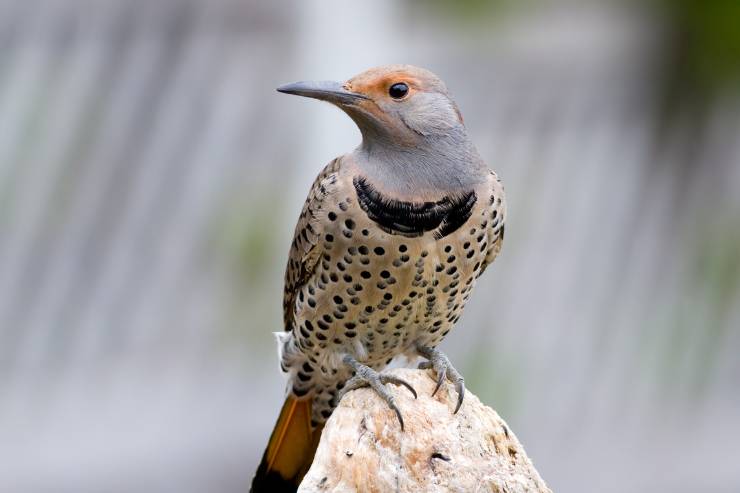
Size and Wingspan of Northern Flicker:
- Length: 28–36 centimeters (11–14 inches)
- Wingspan: 42–54 centimeters (161⁄2 – 211⁄2 inches)
- Size: 86 to 167 grams (3 to 57⁄8 oz)
Although the Northern Flicker is restricted in Texas as a breeding bird, it is common during migration and in the winter.
Northern Flickers are found in woodlands, forest margins, broad fields with scattered trees, and city parks and neighborhoods. These birds avoid deep, continuous forests and require some open land for feeding.
Northern Flickers behave differently than typical woodpeckers. They can climb tree trunks and hammer on the wood. Yet, they feed mainly on the ground, occasionally alongside sparrows and blackbirds.
These Northern flicker’s primary food source is ants, which it locates by digging in the dirt. It eats ants with its long barbed tongue.
2. Canada Warbler (Cardellina Canadensis)
The Canada warbler is a tiny northern songbird from the warbler family. Canada Warblers are metallic blue-grey above and bright yellow below, with a distinct whitish eye.
The apparent appearance of mature males is a shattered black necklace across their chest. Females also have, but it is less prominent. Its lifespan is at least eight years.
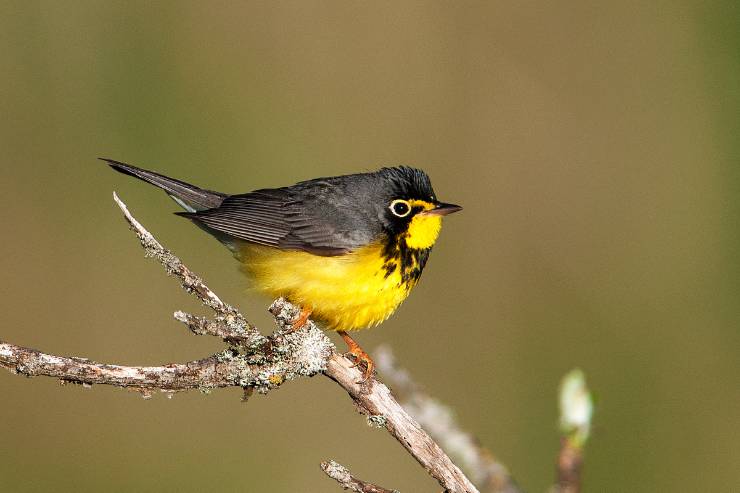
Size and Wingspan of Canada Warbler:
- Length: 12–15 centimeters (4.7–5.9 inches)
- Wingspan: 17–22 centimeters (6.7–8.7 inches)
- Weight: 9–13 grams (0.32–0.46 oz)
Canada Warblers thrive in forest undergrowth and shady bushes. They can also be found in old mixed hardwoods in extensive forests and waterways.
The Canada Warbler enters on the Upper Texas Coast about mid-April but is most common in late April and early May.
Canada Warblers eat a variety of insects and spiders. They hop fast between trees, capturing insects from underneath plants. They also catch flying insects in the air.
3. American Yellow Warbler (Setophaga Petechia)
American yellow warblers are among the most widespread warblers. Both male and female American yellow warblers have yellow and black eyes.
Their wings and backs are yellow-green or gray, and the rest of their body is bright yellow. It can live for up to nine years in the wild.
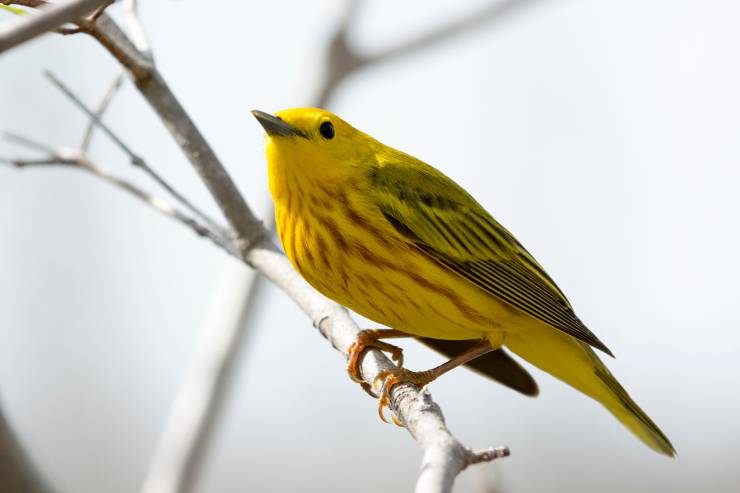
Size and Wingspan of American Yellow Warbler:
- Length: 12.7 centimeters (5 inches)
- Wingspan: 16–20 centimeters (6.5-8 inches)
- Weight: 9–11 grams (0.31–0.38)
American yellow warblers move north to nest in temperate, newly established forests and shrublands spanning from the Arctic Circle to Mexico each spring.
When fall arrives, these species migrate south to Central and South America, where they spend the winter in mangrove forests.
Apart from that, other subspecies of yellow warbler reside in the southern regions all year. It feeds on the tops of shrubs and small trees, flying fast through the branches in search of prey.
They mostly devour insects, with caterpillars and other insect larvae. In the winter, they consume fruit
4. Common Yellow Throats (Geothlypis Trichas)
Common yellowthroats are little songbirds with hefty, rounded heads and medium-length, somewhat curved tails.
Adult males are bright yellow underneath, with a solid black facial mask and olive upperparts.
Female Common yellowthroats are basic olive brown, with yellow on the throat and under the tail. They can live for a year or two; some can even live up to 11 years.
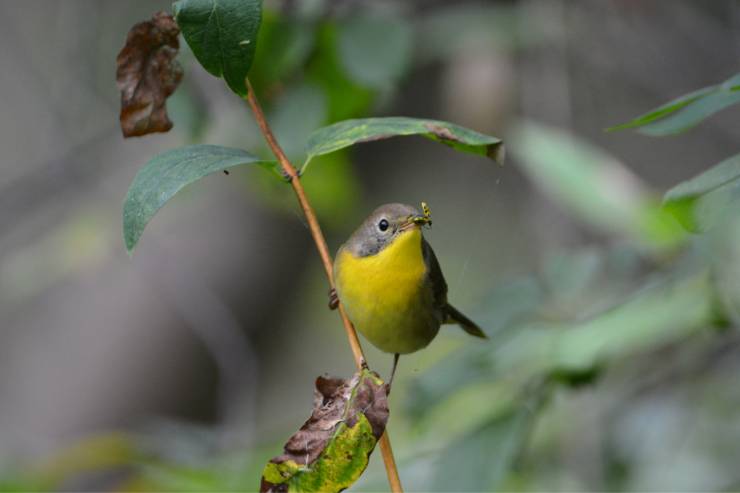
Size and Wingspan of Common Yellow Throats:
- Length: 11–13 centimeters (4.3–5.1 inches)
- Wingspan: 15–19 centimeters (5.9–7.5 inches)
- Weight: 8.5 grams (0.3 oz)
Common Yellow Throat is a year-round resident of Texas. These yellowthroats are territorial among themselves and exclude migrant yellowthroats of other races from their habitat.
These birds prefer marshes, swamps, moist, dense forests, and edges. The Common Yellow throat frequently lives in marshes and other extremely damp areas with thick, low vegetation.
5. Pine Warbler (Setophaga Pinus)
As the name implies, the pine warbler is common in many eastern pine forests and hard to find outside of them.
Pine Warblers are yellow birds with olive backs, whitish bellies, and two noticeable white wing bars on gray wings. They live less than five years.
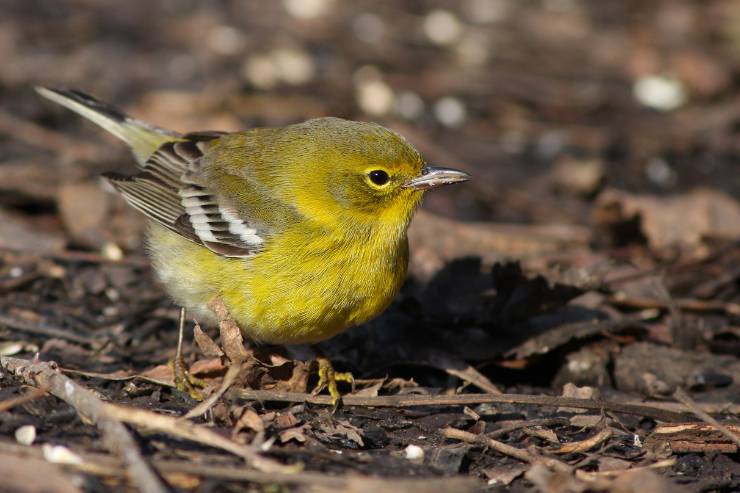
Size and wingspan of Pine Warbler:
- Length: 12–14 centimeters (4.75 to 5.5 inches)
- Wingspan: 22 centimeters (9 inches)
- Weight: 11.9 grams (0.42 oz)
Pine warblers spend almost all of their time in forests filled with pines, staying in the southern United States before making a brief spring migration to more northern regions.
Yet, some have made Texas their permanent residence.
These birds prefer to reside in mature jack pine and pitch pine forests. It is primarily found in pine woods, riparian habitats, and oak woodlands.
Pine warblers like to eat insects, but they also munch on fruits and seeds. They may feed on the ground or approach feeders.
6. Cedar Waxwing (Bombycilla Cedrorum)
Cedar waxwings, also known as the waxwings, belong to the passerine bird family Bombycillidae.
They are medium-sized, slender birds with a big head, small neck, and a brief, extensive bill. Their wings are broad and pointed, and the tail is short and square-tipped.
Cedar Waxwings have pale brown heads and chests, which fade to soft gray wings. Their belly is pale yellow, while the tail is gray with a brilliant yellow tip. These birds can live for up to eight years.

Size and wingspan of Cedar Waxwing:
- Length: 15–20 centimeters (6-8 inches)
- Wingspan: 30 centimeters (12 inches)
- Weight: 28 grams (1 ounce)
The Cedar Waxwing is a widespread winter resident across Texas.
It lives in open woodlands, fruit trees, orchards, and in winter, it is everywhere, including towns. It can be found in berry bushes, in evergreen trees, along rivers, and above ponds.
Cedar waxwings primarily ingest berries and insects. Their yearly diet mainly includes berries and tiny fruits, and they live on various berries.
In the summer, these birds enjoy a variety of insects, such as beetles, ants, caterpillars, and flowers.
7. Wilson’s Warbler (Cardellina Pusilla)
Wilson’s Warbler, scientific name Cardellina pusilla, is a tiny New World warbler. It is bright yellow underneath and yellowish olive above.
Males have a distinctive black hat. The average life span in the wild is six years, but there are reports of these species living for up to eight years.
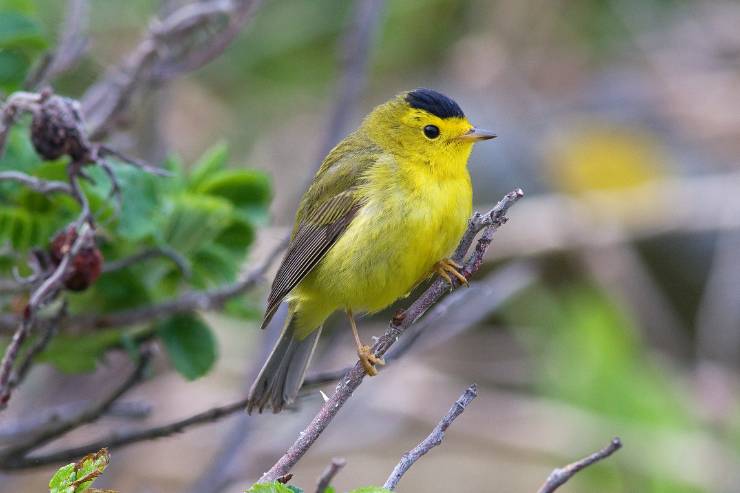
Size and wingspan of Wilson’s warbler:
- Length: 10 to 12 centimeters (3.9 to 4.7 inches)
- Wingspan: 14–17 centimeters (5.5–6.7 inches)
- Weight: 5–10 grams (0.18–0.35 oz)
These birds can be found throughout Canada and the western United States, and they spend their winters in Mexico and Central America.
It is a relatively rare migrant in Western Europe. Wilson’s Warbler is a thicket-dwelling species that prefers moist habitats like ponds, streams, and wet woodland clearings.
Like other warblers, Wilson’s Warbler is most likely an insectivore. Caterpillars, bees, wasps, aphids, and beetles are familiar food sources.
It also eats certain spiders and sometimes berries.
8. Audubon’s Oriole (Icterus Graduacauda)
Audubon’s oriole used to be referred to as the black-headed oriole. Males and females appear comparable, while females are paler.
Adult males Audubon’s oriole have blackheads, lemon-yellow bellies, and yellowish-olive backs.
Kids have darker wings, tails, olive-yellow heads, greenbacks, and a duller yellow belly.
The vivid yellow-and-black Audubon’s Oriole is a quiet woodland and scrub species found in Mexico and South Texas. Its pleasant, rising-and-falling whistles are typically the first indication of its presence.
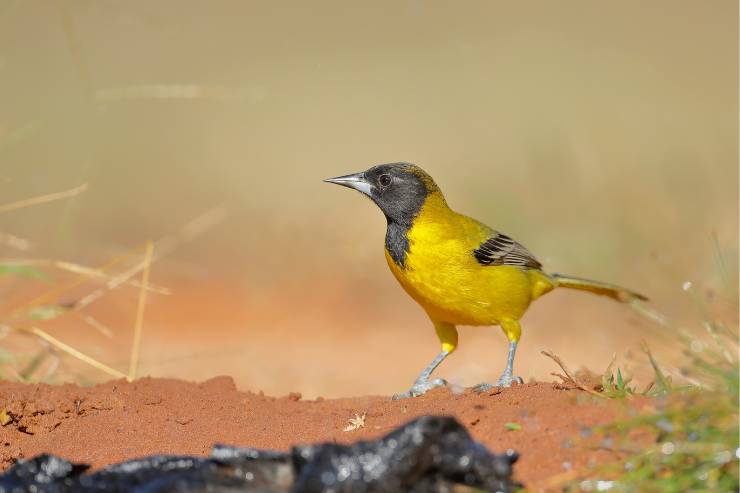
Size and wingspan of Audubon’s Oriole:
- Length: 19–24 centimeters (7.5-9.4 inches)
- Wingspan: 32 centimeters (12.6 inches)
- Weight: 31–53 grams (1.1-1.9 oz)
Audubon’s oriole lives in dense evergreen woodlands and bushes, preferring riparian (riverside) environments.
Although it favors the shade, mated pairs can occasionally be seen feeding in forest clearings.
Audubon’s Orioles live in wooded and brushy habitats in Texas, such as mesquite bosques, woodland streams, and, occasionally, oak stands.
Audubon’s Orioles eat primarily insects, spiders, and fruit, which they gather from plants or the ground, particularly in densely forested places.
9. Lesser Goldfinch (Spinus Psaltria)
The Lesser Goldfinch is a small songbird from America. It has a black tail and huge white corners.
Females and immatures Lesser Goldfinch have olive backs, dull yellow underparts, and black wings with two white wing bars. Its lifespan is at least seven years old.
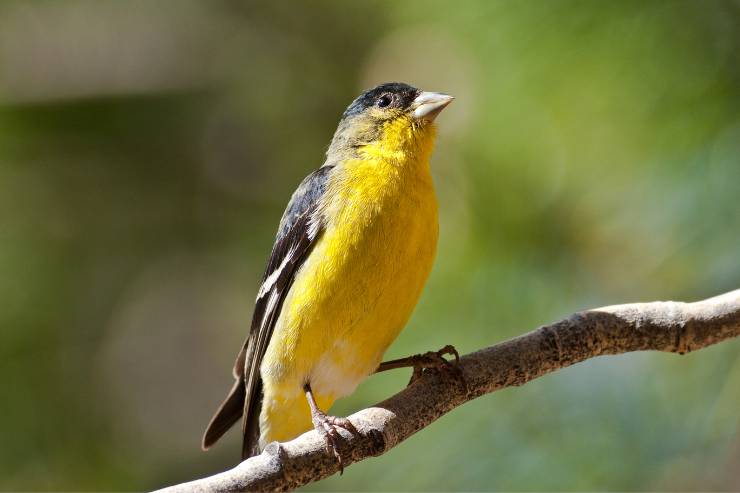
Size and wingspan of Lesser Goldfinch:
- Length: 9- 11 centimeters (3.5-4.3 inches)
- Wingspan: 20 centimeters (7.8 inches)
- Weight: 8-11.5 grams (0.28-0.40 oz)
Lesser Goldfinches are most frequent in Texas and California, with local populations scattered across the other parts of the United States.
It prefers to live in brushy areas, open woods, forested streams, and gardens.
These species favor semi-open settings with thickets and trees near open, weedy fields, ranging from lowlands to high mountains. Lesser Goldfinch is typically found near water in dry areas.
The lesser goldfinch mostly eats plant material, including seeds, buds, flowers, and fruit/berries.
Although not every day, it also eats microscopic insects like mites and plant lice.
10. Couch’s Kingbird (Tyrannus Couchii)
Couch’s kingbird is a passerine tyrant flycatcher from the kingbird genus. It is a yellow-breasted bird with a pale gray head, whitish throat, and gray-brown to slightly green upper parts.
These birds have dark beaks and legs. Couch’s kingbird’s lifetime is unknown. However, like its related, the Tropical Kingbird, it is likely to live for a long time.
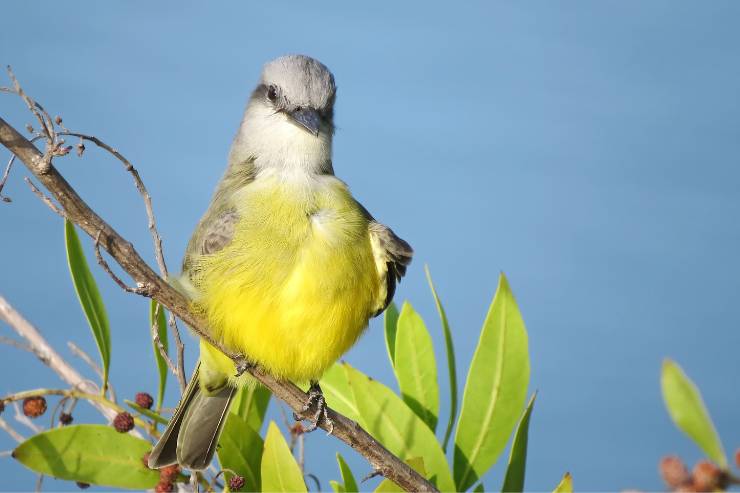
Size and wingspan of Couch’s kingbird:
- Length: 21.59 centimeters (8.5 inches)
- Wingspan: 38.1 centimeters (15 inches)
- Weight: 39.68 grams (1.4 oz)
Couch’s kingbird is found in southern Texas, eastern Mexico, Belize, and northeastern Guatemala.
It thrives in weakly wooded regions such as suburban areas, thorn forests, sparse forests, and the borders of wooded streams.
Couch’s Kingbirds consume primarily flying insects that they catch in flight. They sally from a tree ledge to catch prey and then return to the ledge to eat it.
They also hover to catch insects from leaves and pluck to eat small fruits.
11. Prothonotary Warbler (Protonotaria Citrea)
The Prothonotary Warbler is the sole member of the Protonotaria genus and the only eastern warbler that nests in natural or man-made cavities.
It is vibrant golden yellow, with blue-gray wings, tails, and a yellow-olive back. It has beady black eyes and a solid yellow face.
When viewed from below, the Prothonotary Warbler has white under the tail. Its life expectancy is a minimum of 8 years and 11 months.
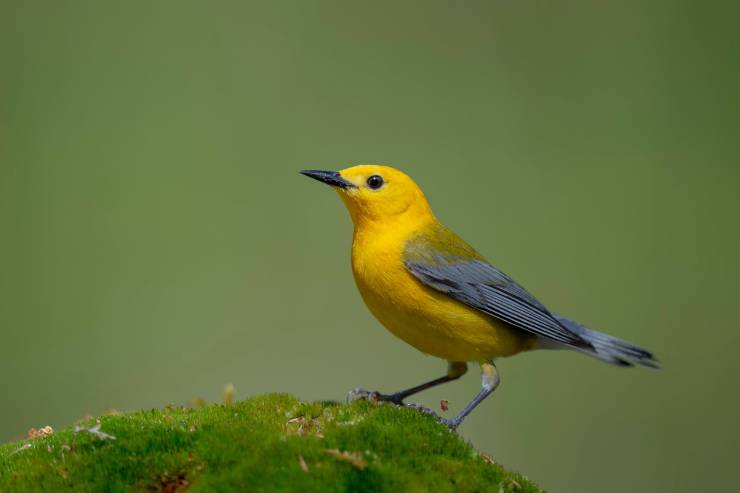
Size and wingspan of Prothonotary Warbler:
- Length: 13 centimeters (5.1 inches)
- Wingspan: 22 centimeters (8.75 inches)
- Weight: 12.5 grams (0.44 oz)
The Prothonotary Warbler can be found in wetlands throughout the eastern United States, including the eastern part of Texas.
It prefers to reside in wooded swamps, flooded bottomland forests, and forest places near streams or lakes.
The Prothonotary Warbler eats adult bugs, larvae (mainly aquatic insects), ants, beetles, snails, caterpillars, mayflies, and spiders. It also eats certain seeds.
12. Great Crested Flycatcher (Myiarchus Crinitus)
The Great Crested Flycatcher is a huge, insect-eating member of the tyrant flycatcher family. It is a typical, huge, and vividly colored flycatcher.
Great Crested Flycatchers are reddish-brown on top, with a brownish-gray head, gray neck and breast, and clear lemon-yellow belly. They can live to at least fourteen years old.
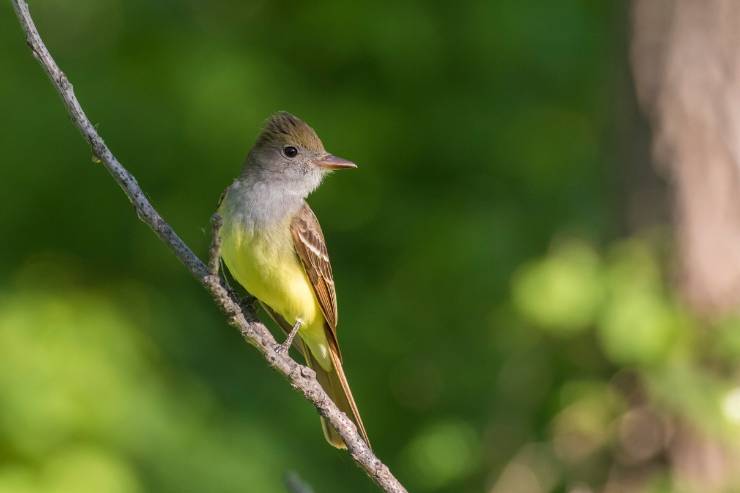
Size and wingspan of Great Crested Flycatcher:
- Length: 17–21 centimeters (6.7–8.3 inches)
- Wingspan: 34 centimeters (13 inches)
- Weight: 27–40 grams (0.95–1.41 oz)
The Great Crested Flycatcher lives in Texas from sea level to around 1000 meters (3500 feet) in shaded deciduous woodland fragments, orchards, and parks.
They prefer to live in mixed or deciduous forests, avoiding pure conifer areas. They can also be found in continuous deep forests and more open forested places near the boundaries of clearings or old orchards.
They prefer mainly insects. They eat various insects, including moths, caterpillars, tree crickets, butterflies, beetles, katydids, and true bugs.
It also eats spiders and small lizards, as well as fruits and berries, on a regular basis.
13. Orange-crowned Warbler (Vermivora Celata)
The scientific name for the Orange-crowned Warbler is Vermivora Celata. Orange-crowned Warblers are generally yellowish or olive. They have a narrow white or yellow stripe above their eyes.
The oldest known Orange-crowned Warbler was at least eight years and eight months old when it was snapped in the wild in the state of California in 2018.
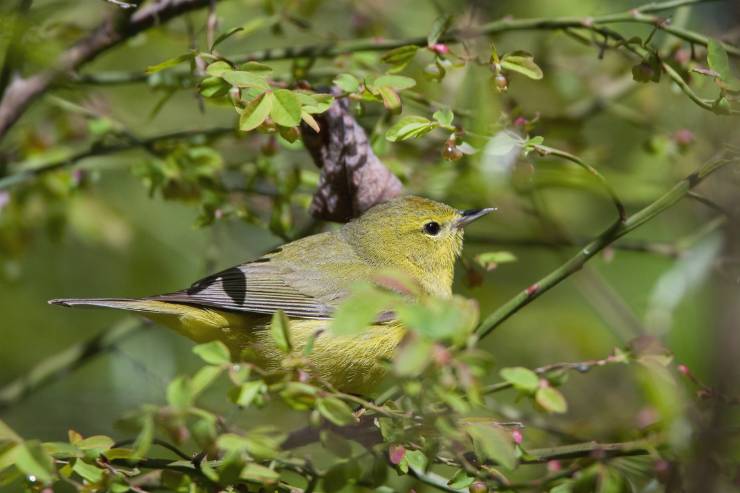
Size and Wingspan of Orange-crowned Warbler:
- Length: 12.19-13.46 centimeters (4.8–5.3 inches)
- Wingspan: 18.41 centimeters (7.25 inches)
- Weight: 9 grams (0.32 oz)
During the winter, the Orange-crowned Warbler bird is found along the upper Texas coast. It is visible from October to April but is not present throughout the summer.
It prefers dense deciduous shrubland, usually within or close to forest.
Orange-crowned Warblers are infrequent in the East but can be seen in late spring, late fall, or winter in low, dense environments in the southeastern United States.
In the summer, Orange-crowned Warblers eat primarily insects, with nestlings surviving almost entirely on bug larvae.
In the winter, they feed on leaking sap from sapsuckers or other woodpecker-drilled wells in tree bark. It feeds on insects, nectar, and berries in the tropical wintering grounds.
14. Western Meadowlarks (Sturnella Neglecta)
Western meadowlarks are medium-sized icterid birds. It has yellow underparts and complexly patterned brown, black, and buff upperparts. These species also has a black V span and brilliant yellow breast, which is gray in the winter.
The Western Meadowlark has a flat head, a long, slender beak, and a round-shouldered posture.
The bird’s wings are rounded and small for its size, while the tail is short, stiff, and spiky.
The oldest Western Meadowlark reported was at least six years and six months old when discovered in Colorado in 1965.
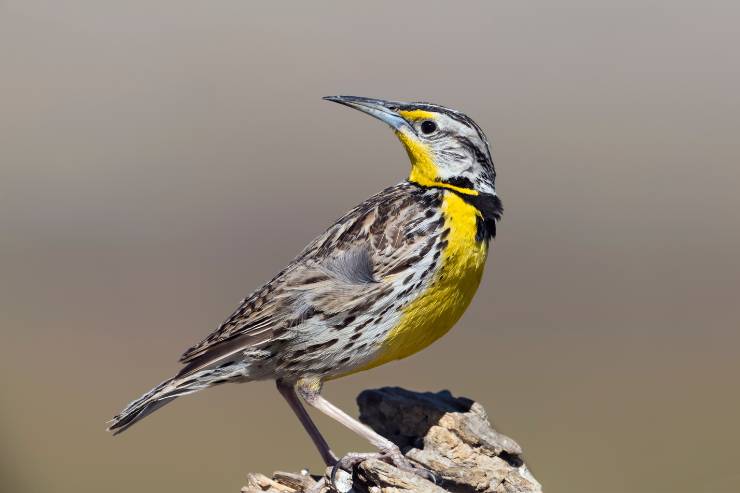
Size and wingspan Western Meadowlarks:
- Length: 15.24-25.4 centimeters (6-10 inches)
- Wingspan: 40.64 centimeters (16 inches)
- Weight: 85.04-113.3 grams (3-4 oz)
Western Meadowlark abundance rises from common to abundant in the western two-thirds of Texas in winter. Western Meadowlarks inhabit grasses, cultivated fields, pastures, meadows, and plains.
They like natural grasslands, abandoned weedy fields, and rangeland but can also live on farmed land. They prefer shorter grass and drier fields to the Eastern Meadowlark’s preferred habitat.
Like many other blackbirds, Western Meadowlark jab their strong, swordlike bills into the dirt before opening their mouths to pry the grass and soil. In the winter, they also devour seeds.
15. Yellow-breasted Chat (Icteria virens)
Yellow-breasted chats have vivid yellow chests and throats, olive green backs and heads.
They also have big white rings around their eyes and a black stripe across their face that leads to their bill. They have a white lower stomach and a yellow upper belly.
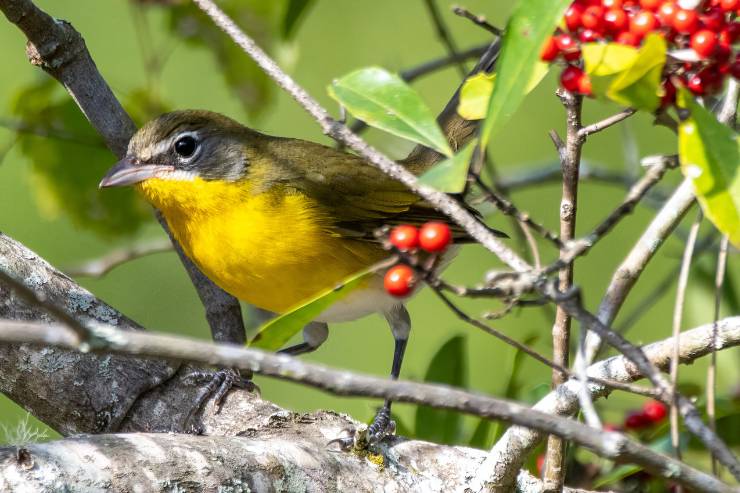
Size and wingspan of Yellow-breasted Chat:
- Length: 17-19.1 centimeters (6.7-7.5 inches)
- Wingspan: 23-27 centimeters (9.1-10.6 inches)
- Weight: 20.2-33.8 grams (0.71-1.19 oz)
The Yellow-breasted Chat lives in the eastern United States, with winters in Mexico and Central America. Some live overwinter in the Southern United States.
It migrates to Texas between early April and early May. They can be challenging to detect since they prefer hiding in deep thickets.
This species is a skulker, preferring low, thick vegetation near forest edges, riparian regions, powerline cuts, and abandoned fields.
These species eat insects found in the leaves of thickets and bushes. They also take fruits and berries when available.
Unlike many other songbirds, they hold their food between their feet before eating it.
Conclusion
Texas has an expanded yellow-bellied bird population, bringing brilliant colors and songs to its rich avian tapestry.
These birds, ranging from the brilliant Northern Flicker to the elusive Yellow-breasted Chat, live in various environments around the state, including woodlands, marshes, and urban parks.
Each species reveals different behaviors and preferences, ranging from the Northern Flicker’s ground-foraging habits to the Yellow-breasted Chat’s skulking attitude.
Through careful observation and conservation efforts, we can continue to appreciate and protect these feathered beauties, ensuring that future generations will enjoy the beauty and diversity of Texas’ yellow-bellied birds for many years.






